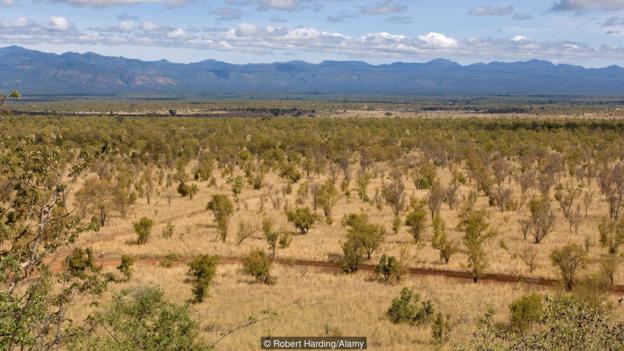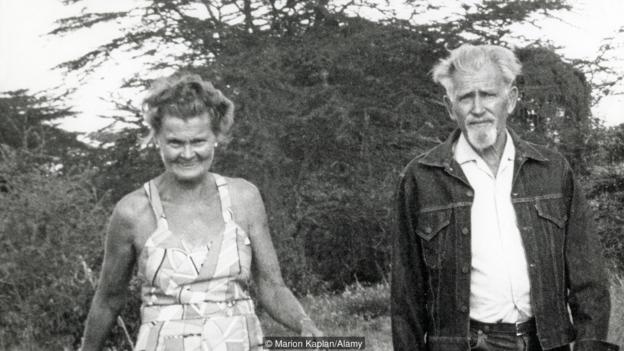The story of the lioness Elsa and the struggle to prevent wildlife hunters
In about a few years of the 60s, the female lion Elsa is the most famous animal alive.
Raised by humans after the death of the mother lion, Elsa is finally brought back to the wild world. This lion's life story has been adapted into a very successful film and inspired thousands of people to participate in wildlife conservation activities.
The house of Elsa is Meru National Park in Kenya. At that time, Meru was the "haven" of thousands of animals with "fame" in the wild world, including lions. However, many years after Elsa's death, the park was devastated by illegal hunters and the wild life was almost wiped out. In just a few years ago, Meru was really covered in green.
This is the story of a long war to reclaim peace for Meru National Park: a war inspired by the story of the lioness Elsa.

Meru National Park was destroyed
The story of the lioness Elsa
Meru National Park is a wild, rugged terrain, stretching over a land twice the area of the Isle of Wight (Isle of Wight). It was once considered an example of the diversity of the environment - grassy steppes are adorned by large herds of buffalo, zebras, elephants, leopards and lions.
In the 1960s, the park became famous all over the world. That's thanks to Born Free - a bestselling book written by Joy Adamson, who recounts the true story of how she raised an orphan lion named Elsa.

Joy and George Adamson
In 1956, Joy's husband George captured a lion (mother of the female lion Elsa) when he was attacked by this animal. However, soon after, he realized that he did it just to protect his children. Therefore, George decided to take Elsa to feed. Joy taught Elsa how to defend herself and when she was strong, Elsa was taken back to Meru National Park. Here, Elsa raised three children before she died in 1961 due to tick-borne disease (a disease determined by tick or tick bite).

Actors in the film Born Free
Elsa's story plays a huge role in promoting the conservation of lions and all other wildlife species on the international agenda. It also contributes to Meru becoming one of Kenya's most important protected areas, attracting tens of thousands of visitors each year to discover the diversity of wild nature.
Wildlife hunting in Meru Park
The conflict began with the Shifta War (Shifta War) in the 1960s when the Somali people in northeastern Kenya rebelled to regain their lands. Later, a ceasefire was established and by 1967, the war was over. However, the area is still insecure when conflicts rise in Ethiopia and Somalia makes the situation worse. Finally, militia forces had to be improved with automatic pistols.
According to Tuqa Jirmo - senior national park supervisor, "most areas are unstable" and "Meru is stuck in the middle".
Meru's ranger force has only a bulky handgun and they cannot resist it.
"The militia forces have machine guns, not simply the same bow and arrow as before." Jirmo said. "Our rangers can stop poachers from animals but when pistols become machine guns, they are completely overwhelmed."
At the same time, demand for ivory is increasing in Asia. This has caused poaching activities to become an attractive source of income for the poor and then, Meru animals have gradually been shot to death.

Elephants are attracted to wildlife hunters
"Ivory and rhino are shot, and other animals are slaughtered . " Jirmo shared. "Poachers think Meru has so many elephants that this creature cannot be extinct. Therefore, conservation is not a concern for them."
In the late 1970s, Meru was the "playground" of hunters and in the next 10 years, the place became "outlaw".
The infrastructure of the park was ruined and narrow roads gradually turned Meru into an isolated land. In addition, the overgrown bush makes this area ideal for hunting. The wild world was destroyed and Jirmo called Meru the "forbidden land".

An African wild buffalo is bathing in mud
"Population" of elephants decreased from 3,000 to a few hundred. Rhino from nearly 100 to completely erased. Hundreds of lions that once roamed the herd in the park were also severely reduced in number.
The Kenya Wildlife Conservation and Management Office has tried to prevent poaching but this campaign is not effective and lacks financial resources.
Part of the problem is that forest rangers do not focus on wildlife conservation. They are not motivated to work because of low wages, obsolete weapons in comparison to hunters' equipment. Any ranger who faces these thieves will not be able to keep his life.
After many rangers were killed by poachers, many survivors decided to ignore and not intervene to protect their lives."The forestry staff did not stop poachers so they were almost free to enter the area," said Tim Oloo, a member of the Born Free Foundation.

White rhinoceros in Meru
This eventually makes the illegal hunting activities become blatant."The bandits claim that they will kill 5 white rhinos directly. Immediately, they come to Meru and take them all, leaving only the horns." Oloo said "nobody does anything to stop these barbaric acts".
At that time, hope for calling people to fight for protection Meru only expected Joy Adamson but in 1980, she died and later, confirmed as being murdered.
The most tragic was 1989. The bandits killed two French tourists to Meru and a month later, George Adámon was also murdered in the nearby Kora National Park. Meru closed the door and the story seemed to close with an ending that didn't have a post.

Today there are very few lions in Meru
Revival of Meru National Park
In 1990, the Kenyan government established the Kenya Wildlife Service to control the operations of the office of wildlife management and conservation due to failures in protecting Meru National Park.
The first step is to restore the park. Supported with $ 1.25 million from the Animal Welfare International Fund, Meru welcomed more than 1,300 animals transferred from other parks over a five-year period, including numbness. cupping, giraffes, zebras, antelope impala, elephants and black rhinos. In addition, the roads are repaired and guest houses are also built. More importantly, forest rangers also began to be trained on how to use automatic guns, communicate with modern radio systems, and security, along with improvements in wages and housing.

Savanna tree grows throughout Meru National Park
10 years later, this new ranger force completely eradicated poachers. Gradually, they were kicked out of Meru and the national park entered the process of reviving from the brink.
Today, poaching is still a threat but it is no longer a massacre. Instead, a built rhino reserve can hold 60 animals and is monitored 24 hours a day. In 2014, two armed poachers tried to kill a white rhino, but eventually they lost themselves.
Meru once again became the home of many animals and more than 400 species of birds. However, you will no longer see Elsa because there are almost no lions.

Meru National Park viewed from above
In February 2016, a survey of the lion's existence in Meru National Park was conducted. The result is only about 80 lions in the entire garden and this number is extremely low. Not only Meru but most of Kenya, the lion's "population" fell sharply, with only about 2,000 remaining alive in comparison to about 100,000 at the time of Elsa's life.
However, there is still hope Meru will become the lion's "home" again.
Jirmo shares "the investigation is only the first step. The next step, we can know each lion, monitor and monitor them. In the coming years, Meru will return to the prosperous period. prosperous like it used to be. "
Trap - the next threat of wild nature in Meru
Traps are deadly wires. People often put them in bushes to catch animals and get meat. The amount of meat collected "will eat or sell".
Victor Mutumah, a member of the Born Free Foundation, said, "The goal is still buffalo, antiquated or antelope impala, but the biggest problem is that they set up traps indiscriminately. Some people trap to catch buffalo but after that, the victim was an elephant ".

A baboon sitting on an olive tree branch
According to him, the root of the trap is because poor communities living in the park's perimeter are struggling in daily life and they are not very sympathetic to the animals.
Elephants in the park trampled on their crops, while lions and leopards killed cattle. This means that local people have a negative attitude towards wildlife and it is very difficult to change.
"For many people, conservation is not their priority , " Mutumah said, "They need to feed their families first."
Worse, some locals consider parks to "keep" rich tourists. It only takes about 350ksh (about £ 2.50) to enter the park but renting a car to travel is much more expensive. This led to most locals never coming to Meru."People don't think they have any direct benefits from the park."

Waterbuck
Now, there has been a serious commitment from the community "to take matters into Meru more seriously because they can benefit in some way" . The important thing is that every time they trap, they tell the government.
If all goes well, in the next few years, more tourists will come to Meru and a new generation of lions will thrive where they once belonged.
- The rage of the herd
- Launching the Alliance for Wildlife Protection
- The huge Burmese python campaign in America
- Re-front the giant crocodile, an incredible big one
- Group of aliens hunters find material to make flying saucers?
- Awarding the dedication to wildlife protection 2013
- Vietnam is about to have a wildlife park
- Award for wildlife protection
- The strange attraction of wildlife at autumn
- The risk of disease from wildlife trade
- Wildlife protection exhibition
- Vietnam cooperates with Cambodia on wildlife
 Animal 'suffering' after hibernation
Animal 'suffering' after hibernation Why do goats climb well?
Why do goats climb well? Scientists were surprised to see chimpanzees eating turtles
Scientists were surprised to see chimpanzees eating turtles Giant catfish died deadly due to drought in Thailand
Giant catfish died deadly due to drought in Thailand